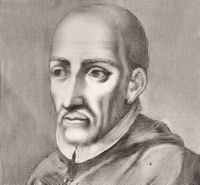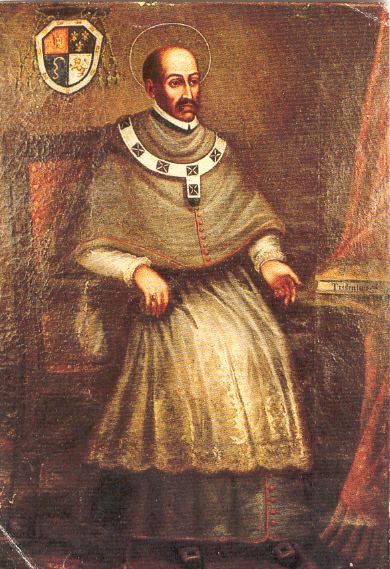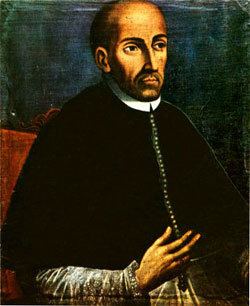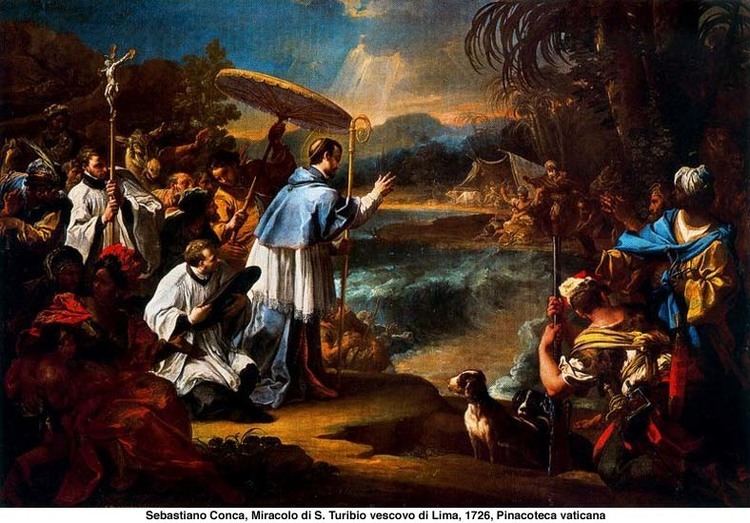Church Roman Catholic Church Name Turibius Mogrovejo Denomination Roman Catholic Rank Bishop | Nationality Spanish Ordination 1578 Patronage Peru | |
 | ||
Archdiocese Roman Catholic Diocese of Lima Consecration August 1580
by Cristobal Rojas Sandoval Born November 16, 1538
Mayorga de Campos, Kingdom of Leon, Spain ( 1538-11-16 ) Died March 23, 1606, Sana District | ||
Successor Bartolome Lobo Guerrero Predecessor Diego Gomez de Lamadrid Education University of Salamanca | ||
Obscure saint st turibius of mogrovejo encounter
Turibius of Mogrovejo (or Toribio Alfonso de Mogrovejo or Toribio de Lima) (16 November 1538 – 23 March 1606) was a Spanish missionary Archbishop of Lima.
Contents

Biography

Born in Mayorga de Campos, Valladolid, Spain, of noble family and highly educated, Turibius was named after another Spanish saint, Turibius of Astorga. He became professor of law at the highly reputed University of Salamanca. His learning and virtuous reputation led to his appointment as Grand Inquisitor of Spain by King Philip II on the Court of the Inquisition at Granada. During this time, he was ordained priest in 1578 and sent to Peru. On May 16, 1579, he was named Archbishop of Lima by Pope Gregory XIII and consecrated bishop in August 1580 by Cristóbal Rojas Sandoval, Archbishop of Seville.

He arrived at Paita, Peru, 600 miles (970 km) from Lima, on 24 May 1581. He began his mission work by travelling to Lima on foot, baptizing and teaching the natives. His favourite topic was: "Time is not our own, and we must give a strict account of it." Three times he traversed the 450,000 square kilometers (170,000 sq mi) of his diocese, generally on foot, frequently defenceless and often alone; exposed to tempests, torrents, deserts, wild beasts, tropical heat, fevers and sometimes threats from hostile tribes; baptizing and confirming nearly one half million souls, among them St. Rose of Lima and St. Martin de Porres.

He built roads, schoolhouses and chapels, many hospitals and convents, and at Lima, in 1591, founded the first seminary in the western hemisphere. He inaugurated the first part of the third Lima Cathedral on 2 February 1604.
Turibius assembled thirteen diocesan synods and three provincial councils. He was seen as a champion of the rights of the natives against the Spanish masters. "There was great opposition to Turibius from the governors of Peru whose authority he challenged," Elizabeth Hallam has written. "He learned local dialects so that he could communicate with–-and convert–-the native peoples, and he was a strong and effective champion of their rights."[1]
Years before he died, he predicted the day and hour of his death. At Pacasmayo he contracted fever, but continued labouring to the last, arriving at Sana (or Saña) in a dying condition. Dragging himself to the sanctuary he received the Viaticum, expiring shortly after on 23 March 1606.
While bishop, he was the principal Consecrator of Alfonso Guerra (bishop), third Bishop of Paraguay; Bartolomé Martinez Menacho y Mesa, Bishop of Panamá; Alfonso Fernández de Bonilla, Archbishop of México; Luis López de Solís, Bishop of Quito; Alonso Ramírez Vergara, Bishop of La Plata o Charcas; Reginaldo de Lizárraga, Bishop of Concepción; and Juan de La Roca, Bishop of Popayán.
Veneration
Turibius de Mogrovejo was beatified by Pope Innocent XI in the year 1679 and was later canonized by Pope Benedict XIII in the year 1726. His liturgical feast was once celebrated on April 27, but currently on March 23. His cult was once confined mainly to South America, but now more widespread because of his pioneering reforms.
Turibius is honored together with Martin de Porres and Rose of Lima with a feast day on the liturgical calendar of the Episcopal Church (USA) on August 23.
